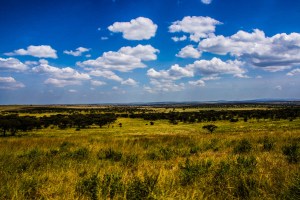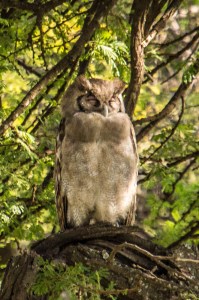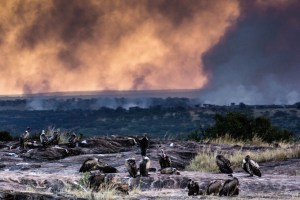The guys at the ‘Kuro’ campsite in the Serengeti make us some hot showers by boiling water on a wood fire and lifting 10 gallon jugs onto the ‘shower’ tube system behind our tents.
It’s a trickle of lukewarm water, but at least I can clear off the accumulated dust-crud from my skin. I’m a golem baked in clay after days of driving exposed on dry dirty roads. Much more dirt and the vultures might mistake me for a kill.

We wave bye to the Kuro guys and our cook Paul. It turns out that he was only to be with us for these first few days. Apparently elsewhere we will be fed by other cooks? Maybe they will get us something besides eggs and salty beef stew.
Today, we are traveling to the Lobo Lodge in northern Serengeti. We are ‘splurging’ for a night in a lodge on our budget safari.
 It’s two hours from the Seronera ‘Kuro’ camp that was in the center of Serengeti to Lobo. The big herds we saw yesterday have moved through already, and the plains seem strangely empty. They thin out more as we drive.
It’s two hours from the Seronera ‘Kuro’ camp that was in the center of Serengeti to Lobo. The big herds we saw yesterday have moved through already, and the plains seem strangely empty. They thin out more as we drive.
 The plains of the south-eastern Serengeti You thought the serengeti was all plains? You would be forgiven if Masaai (Maa) is your native language in which, Serengeti means ‘endless plains.’ There is a lot more to it than just plains, it’s an incredibly diverse ecosystem.
The plains of the south-eastern Serengeti You thought the serengeti was all plains? You would be forgiven if Masaai (Maa) is your native language in which, Serengeti means ‘endless plains.’ There is a lot more to it than just plains, it’s an incredibly diverse ecosystem.
 It’s crossed by a number of rivers and their tributaries, many of which have wild palm trees. Others are boulder-covered with scrub that erupt in flowers only in the dry season. To the west are even swamp lands and forests where the crocodiles and wild dogs hang out.
It’s crossed by a number of rivers and their tributaries, many of which have wild palm trees. Others are boulder-covered with scrub that erupt in flowers only in the dry season. To the west are even swamp lands and forests where the crocodiles and wild dogs hang out.
 Kopjes are rock islands in the sea of grassland that were used in the Movie “The lion King’ which was inspired by the Serengheti. The largest are the size of a baseball field, but most are the size of a house. Lions and other animals use them to get better vision and they can be stunning in the landscape. In the West, there are even swamps and forests.
Kopjes are rock islands in the sea of grassland that were used in the Movie “The lion King’ which was inspired by the Serengheti. The largest are the size of a baseball field, but most are the size of a house. Lions and other animals use them to get better vision and they can be stunning in the landscape. In the West, there are even swamps and forests.
 Up North in the Lobo area, the flat plains turn to rolling hills, which make for great views. The land here has burned more, and large black areas where the grass has scorched appear on eather side of the car as we drive to the lodge.
Up North in the Lobo area, the flat plains turn to rolling hills, which make for great views. The land here has burned more, and large black areas where the grass has scorched appear on eather side of the car as we drive to the lodge.
As we approach, there is a fire burning in the distance and a storm mixing smoke and rain with the fluffy clouds. It’s dramatic even though there aren’t many animals.
The Lion King Big Five
Speaking of the Lion King movie, if you have kids, you’ll be tracking the animals that represent the characters in the movie. Aside from Lions, which are obvious, here are the main ones you’ll want to see.
1) Meerkat – Timon the Meerkat is ‘smart’ half of the duo with Pumba the Warthog. Meerkats are only located in South-Western Africa, mostly Namibia and Botswana and would never have been found in the Serengeti setting of the Lion King. But they do stand on their hind legs cutely. We did not see Meerkat’s sadly.
 2) Warthog – Pumba, known for his farting, is good for some of Lion King’s best laughs. On the savannah, Warthogs are anything but funny. They take every threat with complete seriousness, and run at the sound of anything. Most of my Warthog photographs are of their little wiggly butts scampering away. This one guy did pose for me today in the Serengeti. It’s Savannah bacon! Yum.
2) Warthog – Pumba, known for his farting, is good for some of Lion King’s best laughs. On the savannah, Warthogs are anything but funny. They take every threat with complete seriousness, and run at the sound of anything. Most of my Warthog photographs are of their little wiggly butts scampering away. This one guy did pose for me today in the Serengeti. It’s Savannah bacon! Yum.
 3) Yellow Hornbill – There are many different hornbills, of different colors and sizes around Africa, but Zazu most closely resembles the Yellow hornbill of which we saw many in Kruger park, particularly at Shindzela. They came up and ate with us at breakfast, and could be found on trees everywhere. Zazu, the advisor to the King, could easily have been in the savannah.
3) Yellow Hornbill – There are many different hornbills, of different colors and sizes around Africa, but Zazu most closely resembles the Yellow hornbill of which we saw many in Kruger park, particularly at Shindzela. They came up and ate with us at breakfast, and could be found on trees everywhere. Zazu, the advisor to the King, could easily have been in the savannah.
 4) Hyena – Shenzi, Banzi and Ed are the creepy counterparts of the villan lion, Scar. Hyena and Lion do interact a lot, as hyena’s come from every corner of the plains when a Lion kill is heard and pester the lions to give up the carcass.
4) Hyena – Shenzi, Banzi and Ed are the creepy counterparts of the villan lion, Scar. Hyena and Lion do interact a lot, as hyena’s come from every corner of the plains when a Lion kill is heard and pester the lions to give up the carcass.
Hyenas are truly creepy animals, with a weird marking that looks like a ‘smile’ a la the Joker, strange calls and cackles that sounds like a laugh, knotted mangy fur, and a reputation for scrappy fierceness that is not to be ignored. We’ve seen hyena a bunch of times, never right up close, but many different angles.
cackles that sounds like a laugh, knotted mangy fur, and a reputation for scrappy fierceness that is not to be ignored. We’ve seen hyena a bunch of times, never right up close, but many different angles.
5) Mandrill – Another animal that would not be seen on the Serengeti because it’s mostly in the rain forests of Gabon, is the colorful primate the Mandrill. This was Rafiki, the wise man played by Robert Guillaume of 80’s sitcom Benson fame, who looks a lot like our driver, Saige. Since we didn’t go to West Africa, we didn’t see the Mandrill.
We get a 3 out of 5 on the Lion King Big Five list. You’ll really have to do a lot of travel to get all five. This may be the hardest list of all!
 Saige takes us on a game drive around the Lobo lodge before we check in. Zebra appear in large quantity finally and there are some waterbuck, elephants and giraffe all far away. Saige drives faster and faster, obviously impatient that there are few game to see.
Saige takes us on a game drive around the Lobo lodge before we check in. Zebra appear in large quantity finally and there are some waterbuck, elephants and giraffe all far away. Saige drives faster and faster, obviously impatient that there are few game to see.
 But we hardly notice our speed because all four of us are swatting furiously with fly swatters. These are not normal flies, mind you.
But we hardly notice our speed because all four of us are swatting furiously with fly swatters. These are not normal flies, mind you.
These are African TseTse flies, which are only found in central and East Africa. They are relatives of houseflies, but they are blood-sucking, disease transmitting pests that swarm.
 And at the moment our land rover is packed with them. It’s so distracting that we can’t even pay attention to the drive (not that there is a whole lot to see. Maybe that’s a good thing).
And at the moment our land rover is packed with them. It’s so distracting that we can’t even pay attention to the drive (not that there is a whole lot to see. Maybe that’s a good thing).
The flies hurt when they bite, like a horse-fly but worse. Mosquitos inject you with anesthetic, which is at least a civilized way to suck blood. TseTse bites itch worse that a mosquito too – more intense and it lasts longer.
Use spray? You can’t. There are no chemical deterrents. Wear long sleeves? Ineffective. They can bite through clothes. If that weren’t enough, they carry disease, specifically ‘sleeping sickness’ which is a nurological disorder that makes you go crazy.
Well, aside from Zebra and TseTse flies, we aren’t seeing much up here. But the lodge is genuinely nice. The Lobo lodge is one of the oldest lodges in the Serengeti, built and still owned by the Tanzanian government decades ago on a fantastic Kopje overlooking an incredible vista.  They say when the migration come by Lobo it’s one of the greatest safari sights. The entire plain overlooked by the lodge is covered in the black of migrating wildebeest.
They say when the migration come by Lobo it’s one of the greatest safari sights. The entire plain overlooked by the lodge is covered in the black of migrating wildebeest.
About 10 years ago, the lodge was leased for 99-years to an Indian management company, They have definitely improved service over the Department of Motor Vehicles-style hotel service you got when it was government run. And they improved the decor, albeit with a mix of arabic and indian furniture that is definitely out of place in the northern Serengeti.
 In our haste to lighten our load we left all our swimsuits at the East African Safari office. Doh! Trish was nearly in tears with pain that day, and she was unable to perform her usual role helping the girls sort out clothes. As a result they have underpacked by about half including missing swimsuits.
In our haste to lighten our load we left all our swimsuits at the East African Safari office. Doh! Trish was nearly in tears with pain that day, and she was unable to perform her usual role helping the girls sort out clothes. As a result they have underpacked by about half including missing swimsuits.
 It’s only 70 degrees, and Lily is the only one that wants to go into the pool anyway. It’s built into the rockface, and half of the bottom of the pool is natural, unpolished granite that used to form this Kopje.
It’s only 70 degrees, and Lily is the only one that wants to go into the pool anyway. It’s built into the rockface, and half of the bottom of the pool is natural, unpolished granite that used to form this Kopje.
Emma and I go off and shoot a tutu picture. She’s getting good at conceptualizing the photo before we shoot it. On the way there are these adorable Hyraxes.  Hyraxes are cute furry creatures that look like a cross between a guinea pig and a grey squirrel.
Hyraxes are cute furry creatures that look like a cross between a guinea pig and a grey squirrel.
You’ll hear that they are the ‘closest living relative to the elephant’ which is only sort-of true. But they have my 12 year old completely smitten with their cuteness, and we spend some time getting a special photo for her with hyraxes.
Emma and I walk back from the photo spot back toward the pool and bar. There is some snickering from a few guests that saw my tutu poses. They aren’t sure what to make of us. What do you ask the guy in the pink tutu? How do you start that conversation?
 Sitting at the bar is a portly Indian gentleman. He tells us we should watch out for poisonous green snakes on the property. He identifies himself as the manager. “There is an antidote” he says “but it’s in the city very far away and you might not make it in time.” Great. Thanks for the tip. ‘And you can order drinks from the bar at any time.” he adds, getting the sales pitch in after the warning.
Sitting at the bar is a portly Indian gentleman. He tells us we should watch out for poisonous green snakes on the property. He identifies himself as the manager. “There is an antidote” he says “but it’s in the city very far away and you might not make it in time.” Great. Thanks for the tip. ‘And you can order drinks from the bar at any time.” he adds, getting the sales pitch in after the warning.
Our evening game drive isn’t much better. Trish spits an owl in the tree and he is magnificent. We saw one in Kruger and this one. They are hard to find. And there is another wildebeest kill on the side of the road. I guess the hyenas didn’t want the bones of this one.

At least the TseTse flies have let up from the mid-day swarming. And we get a great long view of the fires in the sunset, including one with dozens of vultures waiting for their turn at a kill.
And to the other side of the vehicle is a large rising moon. It’s like being on a sci-fi planet. Emma and I are really enjoying it. Lily is pouting. She only like the animals. Nine is still a little young to appreciate scenery.
 We all shower and it’s great to get some real electricity, even if only from 5-10pm. Everyone gets fresh charges of kindles, players, computers and camera batteries.
We all shower and it’s great to get some real electricity, even if only from 5-10pm. Everyone gets fresh charges of kindles, players, computers and camera batteries.
Trish is showing a fever (101) though and is worried that she won’t be well enough to travel tomorrow. It is going to be a long day driving south to another park. This is not an easy trip to be sick on. She takes some more ibuprofin and drinks a ton of fluids.
 Her thirst has been almost unquenchable in the past few days. She has to drink (and pee) constantly. She can’t pass up a cold drink and scarfs it down like an addict. It’s strange, but with the fever, maybe she just has some kind of GI disorder? Or a strange reaction to the anti-malarial drug.
Her thirst has been almost unquenchable in the past few days. She has to drink (and pee) constantly. She can’t pass up a cold drink and scarfs it down like an addict. It’s strange, but with the fever, maybe she just has some kind of GI disorder? Or a strange reaction to the anti-malarial drug.
Outside in the sunset is a misty rainstorm next to a smokey fire in the distance, but the fire is safely away. Nature reflects some of our own tension.
Despite the worry, we go to bed easily in the hotel room. We’ll sort it out in the morning.




